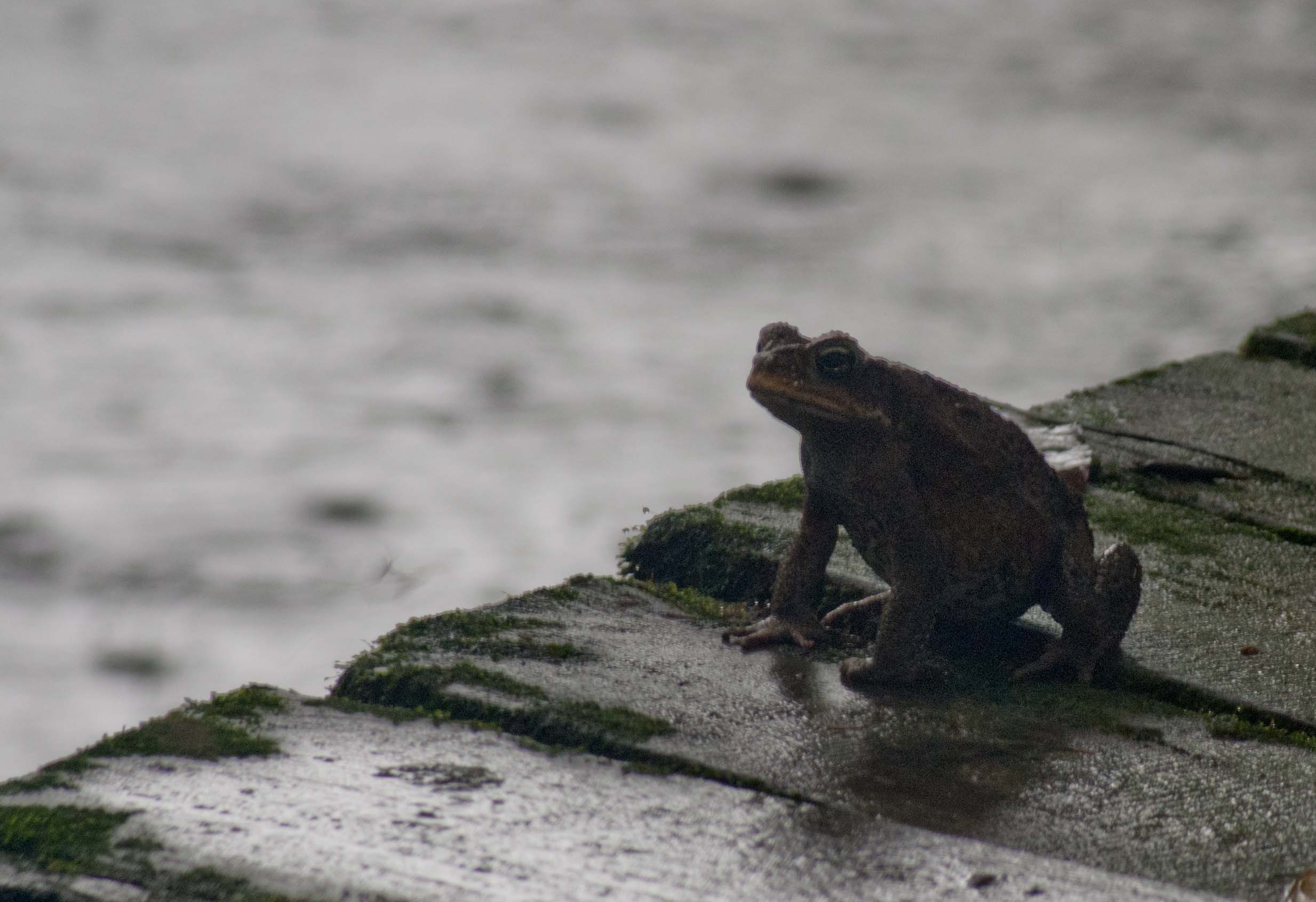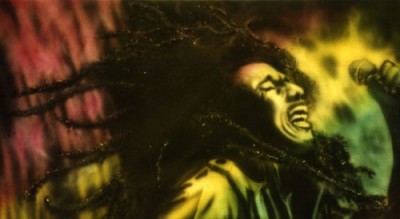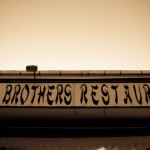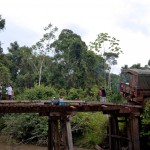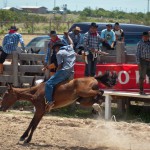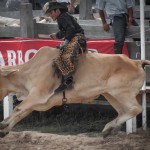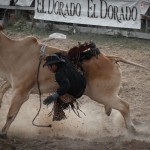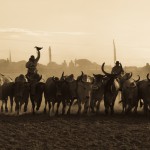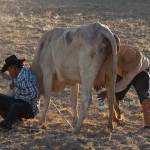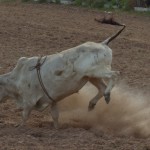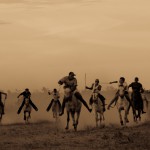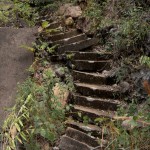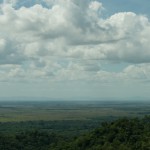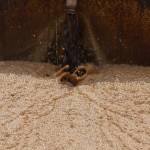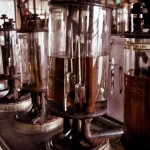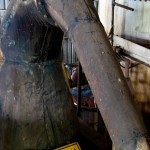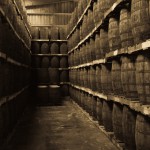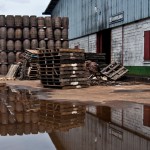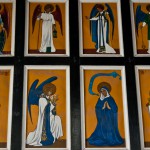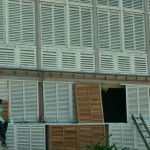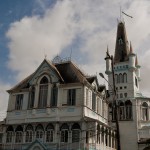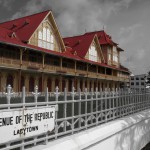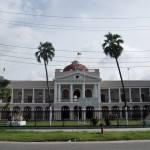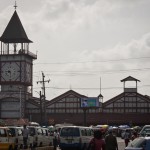The morning begins at 6:30am when frantic packing for my visit to Bartica begins. Bug spray, camera, notepad and change of clothes in a bag – I’m good to go.
Today’s Job
As a VSO volunteer working at Youth Challenge Guyana, part of my job involves setting up tools to monitor the impact of the National Volunteering Teachers Programme on the Community. This Programme recruits, trains and assigns volunteers to schools in remote regions hoping to improve the quality of education across Guyana. The purpose of my visit is to understand the current system used to monitor the impact of this programme so that efficient monitoring systems can be developed and put in place.
Meet G-manGermaine has the responsibility of babysitting me on this trip. As a programme manager at Youth Challenge Guyana, Germaine is responsible for the National Volunteers Teachers’ Programme. He cheerfully puts up with my meaningless banter, patiently explaining how things work on his programme as well as in Guyana. |
 |
Getting there – 3 hours
 30 mins – Boat across the Demerara. The first 10-minute boat ride takes me across the Demerara. However, the wait for the boat to fill up takes 30 mins. No boat leaves the dock until every life jacket houses a man/woman/child who fervently hope that the little orange piece of foam will save their lives (if it comes to that). Under no such false impression, I discard the life vest and find myself admonished for this behavior. The life vest is then thrown back at me and I’m forced to comply. Boatman 1 – Jason 0.
30 mins – Boat across the Demerara. The first 10-minute boat ride takes me across the Demerara. However, the wait for the boat to fill up takes 30 mins. No boat leaves the dock until every life jacket houses a man/woman/child who fervently hope that the little orange piece of foam will save their lives (if it comes to that). Under no such false impression, I discard the life vest and find myself admonished for this behavior. The life vest is then thrown back at me and I’m forced to comply. Boatman 1 – Jason 0.
45 mins – Taxi to Parika. Too easy.
1 hour– Boat across the Essequibo to Bartica. Having received a lesson in boat etiquette on the earlier ride and with G-man for protection, this one’s a breeze.
15 mins– Boat from Bartica to Karrau Creek Primary School
30 mins – Delays due to modes of transport departing ‘just now’
The School Visit
Interviews with the Regional Education Officer, Head Teachers and National Volunteers helped paint a better picture of how the programme operated. National volunteers staffed at schools in the interior face numerous challenges
- Lack of infrastructure – With roads being constantly washed away by rain, accessibility is a huge problem. Added to this is the lack of cellphone signal in some places (never mind the internet), causing problems with communication.
- Heavy workload – Many schools are staffed with 1-2 teachers which means that National Volunteers sometime teach several grades in the school.
- Acceptance by the community – Some communities question the necessity of education and schooling, preferring to send their kids to the fields instead. A lot of friction in these communities makes life difficult for the volunteers.
Added to these challenges is the critical and essential (but boring) task of filling up monitoring forms to provide accountability to donors. Based on the insights from this visit, we hope to make this task painless.
Bartica
Located at the confluence of the Essequibo and Mazaruni rivers, Bartica is a gold town famous for its annual Easter Regatta (boat races). Beautiful views of a blue sky over the river can change in an instant as storms creep up and turn the entire landscape grey. Spending a night out in the town, you’re bound to meet a miner or in my case, the owner of a gold mine. Money flows as freely as the rum and a good time is guaranteed.
If someone tells you that Georgetown’s quiet – they’re probably right. On the other hand, if they tell you Georgetown’s boring – they’re definitely hanging out with the wrong people. Be warned; most of activities listed below require the participation of your entire herd.
Lime at the Seawall
 Liming refers to the art of doing nothing. This term expresses the true essence of the Caribbean way of life – slow down and breathe! Nowhere is this more evident than on the Seawall on a Sunday evening. With half of Georgetown under sea level, the biggest gift the Dutch gave the Guyanese was a tiny 4 feet high wall along the coast to keep sea water out. This is the perfect place to catch the sunset from. Easter being the biggest festival in Guyana, sees the sky at the seawall dotted with hundreds of kites. If you’re not adverse to a small walk, head over to the 19th century lighthouse for a panoramic view of Georgetown.
Liming refers to the art of doing nothing. This term expresses the true essence of the Caribbean way of life – slow down and breathe! Nowhere is this more evident than on the Seawall on a Sunday evening. With half of Georgetown under sea level, the biggest gift the Dutch gave the Guyanese was a tiny 4 feet high wall along the coast to keep sea water out. This is the perfect place to catch the sunset from. Easter being the biggest festival in Guyana, sees the sky at the seawall dotted with hundreds of kites. If you’re not adverse to a small walk, head over to the 19th century lighthouse for a panoramic view of Georgetown.
Swim at a black water creek
 The black water I’m talking about isn’t a euphemism. It’s real. And one of the strangest things I’ve ever seen. Water saturated with minerals causes it to look black and creeks of eerie looking black water can be found at numerous spots away from the coast towards the interior. If the heat gets unbearable, a refreshing dip and a sip of some black water might be the cure. Don’t let the frogs bother you. They’re just interested in the insect buffet.
The black water I’m talking about isn’t a euphemism. It’s real. And one of the strangest things I’ve ever seen. Water saturated with minerals causes it to look black and creeks of eerie looking black water can be found at numerous spots away from the coast towards the interior. If the heat gets unbearable, a refreshing dip and a sip of some black water might be the cure. Don’t let the frogs bother you. They’re just interested in the insect buffet.
Mini-bus trip
My Guyanese friends might not agree with me on this one but one of the most entertaining ways to explore the city is to hop onto a mini-van. With their ever-changing routes, you could see a fair amount of the city riding the same bus everyday. Once you’ve gotten past panicking at ever near death experience (around 2 per ride), this is where you’ll get a first hand view of the idiosyncrasies of the Guyanese culture. 3 out of 4 times you’ll have a drunk on board before noon and the rest of the crowd are quick to pounce on any inappropriate behavior (such as passing out on the only door or on a fellow passenger).
Laugh, sing and dance at the National Cultural Centre
There’s always something going on at the National Cultural Centre. Their strictly enforced formal dress code doesn’t keep away the fun loving crowd (or the hooligans). Serious performances are boring and pop music is the only way to keep the crowd happy. An eclectic mix of Jamaican Dancehall, Trinidadian Soca, American R&B and a token Bollywood song (to calm Indian nerves) is to be expected – be it a contemporary dance concert or a fashion show. If you’re lucky enough to have a comedian show up, there’s not going to be a free seat in the house. Are the comedians funny? No idea. Can’t understand a word.
Feed the Manatees at the Botanical Gardens
 Manatees, commonly referred to as the sea cow are huge grass eating mammals. Given their huge appetite, I’m not sure the zoo keepers are up to the task (see image to the right). If feeding the manatees were something your grandma would do and you need more excitement, then just line up with the school kids and throw rocks at the cougars and lions at the zoo next door. If you don’t want to get too hands-on, you could join the school teachers and observe how the animals react to stones raining down on them (they hide in the corner and pray for real rain). Guyana is a birdwatchers paradise and the bird-watching tour at the Botanical gardens definitely goes onto the list. How do I find and book this tour? That’s still a mystery to me.
Manatees, commonly referred to as the sea cow are huge grass eating mammals. Given their huge appetite, I’m not sure the zoo keepers are up to the task (see image to the right). If feeding the manatees were something your grandma would do and you need more excitement, then just line up with the school kids and throw rocks at the cougars and lions at the zoo next door. If you don’t want to get too hands-on, you could join the school teachers and observe how the animals react to stones raining down on them (they hide in the corner and pray for real rain). Guyana is a birdwatchers paradise and the bird-watching tour at the Botanical gardens definitely goes onto the list. How do I find and book this tour? That’s still a mystery to me.
Catch a cricket match at the National Stadium
 Guyanese love their rum and they love their cricket. Most cricket matches are sold out and all Government offices allow people to skip work if they produce tickets to the match. The drums, the cheerleaders and the crowd will make the experience unforgettable. Take along a cooler with rum or beer and you’re set. Don’t forget to grab some ‘cow face’ during the drinks break. Oh and if you don’t understand cricket, its not a problem. This isn’t about the cricket.
Guyanese love their rum and they love their cricket. Most cricket matches are sold out and all Government offices allow people to skip work if they produce tickets to the match. The drums, the cheerleaders and the crowd will make the experience unforgettable. Take along a cooler with rum or beer and you’re set. Don’t forget to grab some ‘cow face’ during the drinks break. Oh and if you don’t understand cricket, its not a problem. This isn’t about the cricket.
Drink at a rum shop
Rum was invented in the Caribbean. The world’s best rum is brewed in Guyana. Seems fitting that rum shops should be the Country’s most popular pastime. The common philosophy is that no man should have to walk more than a block to get to a rum shop. If you’re looking for a local rum shop, loud music in a residential neighborhood is your first clue. Don’t be fooled by its mom-pop grocery store appearance. That’s just a daytime disguise to help the alcoholics deal with their guilt. Beer being cheaper than coke is the second dead giveaway. 3$ will buy you 250mL of rum and a 500mL of coke.
Wine at The Edge
If drinking in a corner’s not your thing and you’d like to shake your booty a bit, you need to learn to wine. I’m talking about the dance. Women are required to bend forward and place both palms on the floor (ideally) and shake their booty, while the guys stand behind their woman and groove to the beat. Most countries would consider this more than a bit suggestive, but not so in Guyana. If you drop by at the Edge or any other club, you’ll soon realize that any other dance moves are definitely out of place.
Shop at Stabroek Market
 All mini-buses go to Stabroek market, which is the epitome of chaos. Conductors physically trying to load you into their mini-van, musicians on the road, barbers on the footpath, vendors everywhere – that’s Stabroek market for you. Things get taken up a notch on Saturdays – shopping day for locals. Hidden away behind the market is a little jetty with boats ferrying people across the Demerara River, silently feeding the chaos. You either love it or you hate it. I’m lovin it.
All mini-buses go to Stabroek market, which is the epitome of chaos. Conductors physically trying to load you into their mini-van, musicians on the road, barbers on the footpath, vendors everywhere – that’s Stabroek market for you. Things get taken up a notch on Saturdays – shopping day for locals. Hidden away behind the market is a little jetty with boats ferrying people across the Demerara River, silently feeding the chaos. You either love it or you hate it. I’m lovin it.
Is there something I don’t know about? Let me know, and I’ll throw it into my list.
 Guyana is a land of diverse people – Indians, Africans, Portuguese, Chinese all brought to the Continent by colonial rulers. Needing a way to communicate, the slaves combined their language with the language of the rulers to form an entirely new language called Creolese. Creolese though oringally Dutch based shifted to an English based language (once the English threw the Dutch out) and is infused with words and phrases from various other languages.
Guyana is a land of diverse people – Indians, Africans, Portuguese, Chinese all brought to the Continent by colonial rulers. Needing a way to communicate, the slaves combined their language with the language of the rulers to form an entirely new language called Creolese. Creolese though oringally Dutch based shifted to an English based language (once the English threw the Dutch out) and is infused with words and phrases from various other languages.
A few simple steps will help you convert your English to a more swaggerlicious (stylish) Creolese. Add to this some dreadlocks and you’ll be ready for the Caribbean.
Pronouns
Don’t bother yourself with singular or plurals. They’re all interchangeable. Memorize the word that appeals to you the most in each category and stick with it.
- I, Me – ah, me, mi, we, awi
- You, your – yuh, ayu, allyuh
- They, she, he – e, he, she, im, de, dem, aledem
Grammatical rules (in order of increasing difficulty)
Rule 1
End words with ‘in’ instead of ‘ing’.
Cookin. Talkin. Walkin. Childs play.
Rule 2
Replace ‘th’ with ‘d’. Drop the ‘th’ if this rule is too complicated.
‘The’ becomes ‘de or just ‘e’. Whatever makes you happy.
Rule 3
Insert ‘ah’ at the beginning of your sentence to buy you time to think.
Ah wah dah – what’s that?
Ah whey yuh bin – where’ve you been?
Rule 4
Repeat adjectives for emphasis.
Dis wata de cold cold – This water is very cold.
Rule 5
Replace ‘er’ with ‘a’.
Butter would become butta. You might’ve realized I said ‘wata’ in my last rule. Tricky.
Rule 6
Drop h’s at your own discretion.
Maths would become mats and him would be ‘im. I’ll make no false claims and admit that I’m still in the process of internalizing this rule.
Rule 7
If you’ve gotten this far, the world is your playground. Improvise at will.
‘I told him’ can be
- I tol him
- I told ‘im
- I tell ‘im
- Ah tell e
- I tell e
- Me tell em
- And so on and so forth.
Once you’ve mastered these simple rules, its time to take it to the next level.
Phrases
| Phrase | Translation |
| Nah skin yer teet bai! | Don’t laugh boy! |
| Wappening | What’s happening |
| Dem ah watch me (this is Guyana’s unofficial National Anthem) | They (neighbors) watch every move of mine and judge me. Mainly because there’s rubbish on TV. |
| Jus-now | Eventually |
| Meh de pon de fone | I’m on the phone |
Just when you begin to understand what people are saying, they throw a proverb at you. And…you’re back to hitting your head against an easily accessible hard object.
Proverbs
Everyday buckit a go a well, wan day he battam drap out.
Translates to – everyday the bucket goes to the well, one day the bottom drops out.
Means – Repeated practices (good or bad) will have consequences (good or bad). Did you know that this phrase pops up in Bob Marley’s version of “I shot the sheriff“? Go listen.
Ugly pickney nah gat daddie.
Tranlates to – an ugly child does not have a father.
Means – If something goes wrong, most people will say “it wasn’t me”. In case you’re wondering, this phase is not related to “who’s your daddie.”
Orange yellow but yuh nah know if it sweet.
Translates to – A orange the is yellow isn’t necessarily sweet.
Means – don’t judge everything by appearances.
Guyanese proverbs are guaranteed to help you kill some time at the office.
As with all languages, if you want to sound like Captain Jack Sparrow (substitute your favorite Rasta-man’s name here) there’s only one way – practice, practice, practice!!
New Amsterdam is one of Guyana’s largest towns. It comprises of 3 main roads parallel to each other with numerous tiny streets linking these roads. The town is 3kms long and half a kilometer wide with a population of around 30,000.
The largest industry here is Christianity. Main Street boasts of 8 churches – Lutheran, Roman Catholic, Anglican and even Ethiopian Orthodox to name a few. Even though some of these Churches date back to the 19th century, it is a bit disappointing that none of them are worth writing home about. Given the popularity of Churches, it was ironic that Church View Hotel (where I spent the night) was located bang across the only Mosque in town.
Church hopping helps you build up quite an appetite and the (always) enterprising Chinese community stepped in to fill that gap. They might’ve taken it a bit to far. Chinese restaurants are second only to Churches by number. From the swanky and suspiciously quick Sue Brothers to the not so well informed Hong Kong Great Wall restaurant, your Chow Mein craving will not go unsatisfied.
Apart from Churches and Chinese restaurants, there’s absolutely nothing to do here. Local youth, presumably bored from the lack of entertainment carted a few speakers onto the road and turned up the volume. Armed with beers, a small crowd gathered to investigate. In line with Guyanese tradition, no song was allowed to play for longer than a minute. If that wasn’t bad enough, the DJ refused to let any song play uninterrupted for 10secs – saying something incomprehensible (I’ve got to work on my Creolese) on the mic.
The most memorable part of a trip to New Amsterdam is definitely the mini-van ride. From the music to the conductor to the interactions between passengers – it’s all so refreshingly different from everywhere else in the world that if you can get past the crazy driving, you might actually enjoy the flavor of Guyana that gets served up to you here. However, if you do end up waking up early and think of catching a 5$ bus from Georgetown to New Amsterdam, I would highly recommend suppressing that feeling of irrational impulsiveness. Although New Amsterdam is one of the Guyana’s largest towns, it’s definitely not built to be a tourist destination.
As a tiny town in southern Guyana bordering Brazil, Lethem’s claim to fame is the annual Easter rodeo. With everyone in Georgetown talking only about the rodeo in the weeks leading up to Easter, I was left with little choice but to board a bus to Lethem.
500kms separates Georgetown from Lethem – 400 of which is mud. It doesn’t end there. Once you’ve resigned yourself to the fact that your vehicle will periodically get stuck in wet mud, you then have the bridges to contend with. Please note that these are no ordinary bridges. Made entirely from wood, they have a tendency to crumble under the weight of passing trucks. Bet the engineer didn’t see that one coming. Even after making allowances for these distractions, 30 hours to cover 500kms is shocking and a backbreaking experience.
Putting the horrible roads aside, the constantly changing landscape is breathtaking. Coastal vegetation slowly gives way to wet, untarnished and dense rainforest – the jaguar’s playground. Driving into southern Guyana, the forest seamlessly makes way for the savannah. And what a sight that is! Grass all around extending until the horizon, dotted with anthills and without a tree in sight. An anteater’s paradise.
The annual Easter rodeo features a blend of Guyanese and Brazilian cultures with some Jamaican music thrown in for good measure. Entertainment for the weekend includes wild horse riding, wild bull riding, wild cow milking, greasy pig catching and greasy pole climbing among other attractions. All this under the scorching sun. Something about watching grown men foolishly attempt to ride wild animals and then fail miserably makes for a great afternoon. Nightfall sees the music being cranked up to keep pace with the drunken celebrations.
Moca Moca waterfalls fall into the rocky stream rather than gigantic waterfall category. Huge pools of water and large rocks encourage cannonballs. Picture this for a lazy Sunday afternoon – sitting by the edge of a creak bathing in sunlight diffusing through tall trees and your legs immersed in cold stream water. Perfection would require a cold beer. Maybe next time. Not so sure why anyone would leave all this behind to climb 1000 stairs to the top of a mountain, braving the sun and risking drowning in your own sweat. The ‘peak’ (for lack of a better word) offers a spectacular view of the savannah and a few green hills. However, the intense heat makes the waterfall preferable.
A trip to Lethem should be on the cards of any tourist in Guyana. While the rodeo may not be around the rest of the year – a stop at the Iwokrama forest for a canopy walk or a dash across the border into the Brazilian towns of Bom Fin and Boa Vista seem like reasonable alternatives. Caiperinjas anyone?
Objective – To produce the best rum in the World
Ferment > Distil > Age > Consume
Stage 1 – Ferment

Input – yeast, molasses, water
Equipment – huge vats and lots of large pipes (preferably intertwined in a complicated manner)
Procedure
- Grow yeast in huge vats by maintaining perfect conditions for replication. Mood music not necessary. Estimated time – 6 hours.
- Mix yeast with molasses and water.
- Throw in anti foaming substance for good measure. Add sulfuric acid to taste. Keep temperature below 37 degrees.
- Leave the mixture alone for 24 hours.
Output – Carbon dioxide and dead wash
Stage 2 – Distil

Input – dead wash and steam
Equipment – Stills, condensers, pipes, glass beakers, pipettes and log books
Procedure
Equipment – Stills, condensers, pipes, glass beakers, pipettes and log books
Procedure
- Transfer the dead wash from fermenting plant into huge cylindrical stills while blowing steam through these stills to vaporize the dead wash. These fumes are then converted into pure alcohol in the condenser.
- Different stills give flavors to the alcohol. Coffey, wooden and pot stills are some still options.
- Mad scientist equipment helps staff monitor the consistency of the alcohol.
- Once the alcohol has been extracted, dump all waste into the river*. Don’t let your conscience bother you about that. The law sure as hell won’t.
Output – 18 different alcohol varieties with varying consistencies, compositions, flavours and colours.
Stage 3 – Age

Input – pure alcohol from stage 2
Equipment – Wood, iron, rain, sunshine
Procedure
Equipment – Wood, iron, rain, sunshine
Procedure
- Mix different quantities of different rums to produce a rum blend. Adult supervision required.
- Build a casket from the wood using iron clamps and leave it out in the rain for a few days to ensure that the wood absorbs water and binds together well.
- Air pressure test the cask before sealing blended rum in it for up to 80 years in some cases. Your kids will thank you for your patience.
Output – The world’s best rum
Stage 4 – Consume

Conclusion – Demarara distilleries produces 20,000 bottles of rum per day. The warehouse unit houses more than 36,000 caskets of rum. El Dorado 5 year rum is the best rum in the below 7 year category and has won that award over the last 7 years. El Dorado 15 year rum is the best rum. Period. Our friendly neighbourhood rum connoisseur observed (and I concur) that the following mapping holds true for good rums
- 21 years = cognac
- 15 years = scotch
- 12 years = brandy
- 6 years = vodka
- 5 years = tequila
- 3 years = rum rum
* The distillery has opened a new bio gas plant next door to the distillery and is using its waste to generate bio fuel to power the distillery. The CO2 released from the fermentation is used to make dry ice and Pepsi. Although these practices are somewhat sustainable, the brown waste flowing into the river shows that this token effort isn’t enough and there’s a lot of work to be done on this front.
On landing at the Cheddi Jagan International airport in Guyana, the Calypso playing on the speakers sets the expectations right. Georgetown may be part of South America but make no mistake – you’re in the Caribbean!!
First Glance
Georgetown stands a good chance of being the world’s laziest city (if it can be called a city). With a population of 200,000 the roads are relatively empty and traffic rules non-existent. 200 years of colonial mud-slinging between the British, French, Portuguese and Dutch has given Georgetown a more than colorful history. The eclectic mix of churches and buildings dotting the town bear witness to that. Like most of the buildings around, my guest house is built completely from wood. Living on the 2nd floor of a rickety wooded building rocks. Literally. Somewhere in the house a door slams shut and the entire building seems to shake on its foundation (if any).
The Best Part
The 45km drive from the airport to Georgetown offers an intoxicating scent of both rum and beer distilleries which are part of Guyana’s largest industry (sugarcane – rum…same thing). Guyana’s rum – El Dorado has brought home numerous awards for one of the world’s best rums. Even more reason to not complain about rum being cheaper than Coke in these parts. Did you know that Guinness brews its beer in Georgetown?? A tour of the rum distillery is battling the Kaieteur falls (world’s largest single drop waterfall) for top spot on my tourist agenda.
Lifestyle
Music’s in the air at all points in time right from the street CD vendors to food stalls to passing vehicles. People even seem to sing as they speak. Seems fitting for the Caribbean. This musical passion is possibly overshadowed by only one other countrywide obsession – cricket. With the world cup going on, the only thing playing on all televisions is repeats of older cricket matches. Even though the West Indies were knocked out in the quarterfinals, people still seem interested. Random people were hugging each other at a local food court when India won the World Cup. Didn’t seem to make any sense. I think I’m going to like it here.
Cost of Living
a) Beer – USD 1.5 at posh places and USD 1 at local bars
b) Call a cab – USD 1.5 from anywhere to anywhere
c) Cab off the street – USD 2 from anywhere to anywhere (don’t ask why)
d) Rum – USD 4-5 per bottle
e) Big night out – USD 15 (including dinner)
f) Big Mac – dream on
The Downside
Hot water showers are a rather elusive commodity here and can only be found at the swankiest hotel in town. Regular mortals and underpaid volunteers have to suck it up and jump into moss ridden cold showers. Wireless internet made it’s way to Georgetown just fine, but somehow washing machines didn’t.
Right now – belly full behind drunk*. Time for some shut eye.
*Local proverb: eat + drink = laziness









